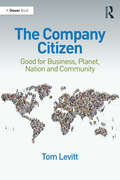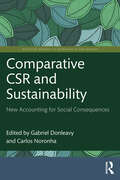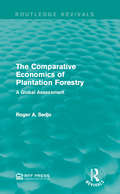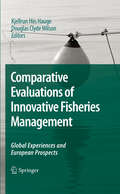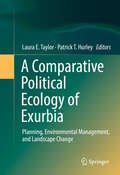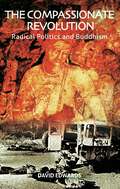- Table View
- List View
A Companion to Global Environmental History (Wiley Blackwell Companions to World History)
by J. R. McNeill Erin Stewart MauldinThe Companion to Global Environmental History offers multiple points of entry into the history and historiography of this dynamic and fast-growing field, to provide an essential road map to past developments, current controversies, and future developments for specialists and newcomers alike. Combines temporal, geographic, thematic and contextual approaches from prehistory to the present day Explores environmental thought and action around the world, to give readers a cultural, intellectual and political context for engagement with the environment in modern times Brings together environmental historians from around the world, including scholars from South Africa, Brazil, Germany, and China
A Companion to Health and Medical Geography (Wiley Blackwell Companions to Geography)
by Tim Brown Sara McLafferty Graham MoonThis Companion provides a comprehensive account of health and medical geography and approaches the major themes and key topics from a variety of angles. Offers a unique breadth of topics relating to both health and medical geography Includes contributions from a range of scholars from rising stars to established, internationally renowned authors Provides an up-to-date review of the state of the sub-discipline Thematically organized sections offer detailed accounts of specific issues and combine general overviews of the current literature with case study material Chapters cover topics at the cutting edge of the sub-discipline, including emerging and re-emerging diseases, the politics of disease, mental and emotional health, landscapes of despair, and the geography of care
A Companion to Political Geography (Wiley Blackwell Companions to Geography)
by Katharyne Mitchell Gerard Toal John A. AgnewA Companion to Political Geography presents students and researchers with a substantial survey of this active and vibrant field. Introduces the best thinking in contemporary political geography. Contributions written by scholars whose work has helped to shape the discipline. Includes work at the cutting edge of the field. Covers the latest theoretical developments.
The Company Citizen: Good for Business, Planet, Nation and Community
by Tom LevittBusiness doing good is doing good business; this book learns from the era where governments ruled the world, pre-globalisation, and where business looked after itself, where issues like climate change, resource depletion and even poverty and hunger were not thought to be the responsibility of business. The Company Citizen concludes that not only are these key issues for business today but that the world will not be able to manage these issues without the active participation - even leadership - of business. Aware of the shortcomings of both government and civil society the author argues that environmental sustainability, economic and social inclusion and the better management of resources are all key issues for business and that it makes good business sense to manage them better. This book examines the case for the company citizen on a global, national and community level working alongside other. Never has the conscientious company citizen, as envisaged by 19th century Quaker philanthropists, been more needed; and never has that business case, one that justifies a long-term commitment to practical corporate behaviour for good, been more clear. Drawing attention both to the businesses that are taking the lead and those who are holding us back, the author concludes that only by involving business can we tackle the great issues of the day - and survive, as communities, nation and planet.
The Company Citizen: Good for Business, Planet, Nation and Community
by Tom LevittBusiness doing good is doing good business; this book learns from the era where governments ruled the world, pre-globalisation, and where business looked after itself, where issues like climate change, resource depletion and even poverty and hunger were not thought to be the responsibility of business. The Company Citizen concludes that not only are these key issues for business today but that the world will not be able to manage these issues without the active participation - even leadership - of business. Aware of the shortcomings of both government and civil society the author argues that environmental sustainability, economic and social inclusion and the better management of resources are all key issues for business and that it makes good business sense to manage them better. This book examines the case for the company citizen on a global, national and community level working alongside other. Never has the conscientious company citizen, as envisaged by 19th century Quaker philanthropists, been more needed; and never has that business case, one that justifies a long-term commitment to practical corporate behaviour for good, been more clear. Drawing attention both to the businesses that are taking the lead and those who are holding us back, the author concludes that only by involving business can we tackle the great issues of the day - and survive, as communities, nation and planet.
Comparative Aeronomy (Space Sciences Series of ISSI #29)
by Andrew F. Nagy A. Balogh Thomas E. Cravens Michael Mendillo Ingo Müller-WodargAndrew F. Nagy Originally published in the journal Space Science Reviews, Volume 139, Nos 1–4. DOI: 10. 1007/s11214-008-9353-0 © Springer Science+Business Media B. V. 2008 Keywords Aeronomy The term “aeronomy” has been used widely for many decades, but its origin has mostly been lost over the years. It was introduced by Sydney Chapman in a Letter to the Editor, entitled “Some Thoughts on Nomenclature”, in Nature in 1946 (Chapman 1946). In that letter he suggested that aeronomy should replace meteorology, writing that the word “meteor is now irrelevant and misleading”. This proposal was apparently not received with much support so in a short note in Weather in 1953 Chapman (1953)wrote: “If, despite its obvious convenience of brevity in itself and its derivatives, it does not commend itself to aeronomers, I think there is a case for modifying my proposal so that instead of the word being used to signify the study of the atmosphere in general, it should be adopted with the restricted sense of the science of the upper atmosphere, for which there is no convenient short word. ” In a chapter, he wrote in a 1960 book (Chapman 1960), he give his nal and de nitive de nition, by stating that “Aeronomy is the science of the upper region of the atmosphere, where dissociation and ionization are important”. The Workshop on “Comparative Aeronomy” was held at ISSI during the week of June 25–29, 2007.
Comparative CSR and Sustainability: New Accounting for Social Consequences (Routledge Research in Sustainability and Business)
by Gabriel Donleavy Carlos NoronhaThis book breaks new ground by providing a structured and cohesive set of contributions on the actions, developments, problems and theories of corporate social responsibility (CSR). With new case studies from the UN’s Least Developed Countries (LDCs), contributors in this book investigate how firms in Eastern and Western countries are responding to and making use of evolving CSR guidelines. The book addresses the following questions: is CSR simply greenwashing or an authentic commitment to responsible corporate citizenship? Has globalization drawn CSR conduct in LDCs closer to that of industrialized countries? Stakeholder theory, actor–network theory and a new orbital theory of accountability are applied to give coherence to the case studies. Other chapters address greenwashing in reports, the impact of CSR in socially stigmatized occupations, an analysis on what responsibility precisely entails in CSR, and the interface between law and CSR. The book also considers the impact of COVID-19 on the hospitality industry, and includes a contribution from Ukrainian scholars, one written while their city of Kharkiv was under attack by Russian forces. This book will be a useful reference to those interested in discussions on crises, climate change, and SDGs and realizing sustainable goals through CSR.
Comparative CSR and Sustainability: New Accounting for Social Consequences (Routledge Research in Sustainability and Business)
by Gabriel Donleavy and Carlos NoronhaThis book breaks new ground by providing a structured and cohesive set of contributions on the actions, developments, problems and theories of corporate social responsibility (CSR). With new case studies from the UN’s Least Developed Countries (LDCs), contributors in this book investigate how firms in Eastern and Western countries are responding to and making use of evolving CSR guidelines. The book addresses the following questions: is CSR simply greenwashing or an authentic commitment to responsible corporate citizenship? Has globalization drawn CSR conduct in LDCs closer to that of industrialized countries? Stakeholder theory, actor–network theory and a new orbital theory of accountability are applied to give coherence to the case studies. Other chapters address greenwashing in reports, the impact of CSR in socially stigmatized occupations, an analysis on what responsibility precisely entails in CSR, and the interface between law and CSR. The book also considers the impact of COVID-19 on the hospitality industry, and includes a contribution from Ukrainian scholars, one written while their city of Kharkiv was under attack by Russian forces. This book will be a useful reference to those interested in discussions on crises, climate change, and SDGs and realizing sustainable goals through CSR.
The Comparative Economics of Plantation Forestry: A Global Assessment (Routledge Revivals)
by Roger A. SedjoPlantation forestry is the planting, managing, and harvesting of trees for the production of industrial wood. Originally published in 1983, the principal focus and contribution of the study lies in Roger Sedjo’s examination of the economic returns in twelve forest regions throughout the world. The results of the analysis strongly demonstrate the feasibility of major expansion of plantation forestry in a number of areas around the world and suggest the likelihood of major shifts in the principal supply areas. The results also have potentially important implications for countering the threats of deforestation. This title will be of interest for students of Environmental Studies.
The Comparative Economics of Plantation Forestry: A Global Assessment (Routledge Revivals)
by Roger A. SedjoPlantation forestry is the planting, managing, and harvesting of trees for the production of industrial wood. Originally published in 1983, the principal focus and contribution of the study lies in Roger Sedjo’s examination of the economic returns in twelve forest regions throughout the world. The results of the analysis strongly demonstrate the feasibility of major expansion of plantation forestry in a number of areas around the world and suggest the likelihood of major shifts in the principal supply areas. The results also have potentially important implications for countering the threats of deforestation. This title will be of interest for students of Environmental Studies.
Comparative Evaluations of Innovative Fisheries Management: Global Experiences and European Prospects
by Kjellrun Hiis Hauge Douglas Clyde WilsonComparative Evaluations of Innovative Fisheries Management begins with a look at four places outside the European Union known for innovative management: New Zealand, Nova Scotia, Alaska and Iceland. Then the focus shifts to the success criteria related to specific disciplines including biological and social robustness, economic efficiency and impacts on management costs. Hypotheses are tested using data capable of generating useful results. The main conclusions include a retrospective of how key concepts defined and represented the various perspectives, skills and backgrounds that made up the multidisciplinary CEVIS project.
A Comparative Geography of China and the U.S. (GeoJournal Library #109)
by Rudi Hartmann Jing'Ai Wang Tao YeThe book is the outcome of a unique venture: a team of Chinese geographers and a team of American geographers collaborated on a new Comparative Geography of China and the United States. The book meets a high demand for comparative information about China and the United States, as the home of the two leading economies in a globalizing world. Comparisons of the two countries include the similarities and differences in their physical environments and natural hazards, the growth and changing spatial distribution of population and ethnic groups in China and the U.S., traditions and contemporary regional expressions of agriculture and food production as well as the rapidly changing urban and industrial patterns in both countries. The book also highlights the two countries’ interconnectedness, in trade and in the exchange of cultural, social, scientific & technological information. The volume serves as a major resource in geographic education as it contributes to a better and more comprehensive understanding of the formation and development of the two countries’ basic geographical patterns and processes.
A Comparative Political Ecology of Exurbia: Planning, Environmental Management, and Landscape Change
by Laura E. Taylor Patrick T. HurleyThis book is about politics and planning outside of cities, where urban political economy and planning theories do not account for the resilience of places that are no longer rural and where local communities work hard to keep from ever becoming urban. By examining exurbia as a type of place that is no longer simply rural or only tied to the economies of global resources (e.g., mining, forestry, and agriculture), we explore how changing landscapes are planned and designed not to be urban, that is, to look, function, and feel different from cities and suburbs in spite of new home development and real estate speculation. The book’s authors contend that exurbia is defined by the persistence of rural economies, the conservation of rural character, and protection of natural ecological systems, all of which are critical components of the contentious local politics that seek to limit growth.Comparative political ecology is used as an organizing concept throughout the book to describe the nature of exurban areas in the U.S. and Australia, although exurbs are common to many countries. The essays each describe distinctive case studies, with each chapter using the key concepts of competing rural capitalisms and uneven environmental management to describe the politics of exurban change. This systematic analysis makes the processes of exurban change easier to see and understand. Based on these case studies, seven characteristics of exurban places are identified: rural character, access, local economic change, ideologies of nature, changes in land management, coalition-building, and land-use planning.This book will be of interest to those who study planning, conservation, and land development issues, especially in areas of high natural amenity or environmental value. There is no political ecology book quite like this—neither one solely focused on cases from the developed world (in this case the United States and Australia), nor one that specifically harnesses different case studies from multiple areas to develop a central organizing perspective of landscape change.
Comparative Population (large print)
by RnibThese pages show a map, a table and some graphs comparing the populations of Newham, Chelsea and London. It is a multi-page image set on four pages. There is a locator dot shown on each page, which will be at the top left when the image is the correct way up. Location of Chelsea and Newham: This is a map of Greater London and the image is surrounded by an image border. There is a north arrow in the top right corner and a scale in the bottom right corner. The area of Greater London is shown as a textured area (grey on large print image). The River Thames goes from the bottom left corner to the centre right of the page. It is shown as a thick line. Chelsea and Newham are marked by an open circle. Chelsea is in central London near the Houses of Parliament and Newham is in the east end of London. Heathrow airport is marked in the left centre of the page. Population comparison: This page shows a table of four columns and four rows. It gives comparative population data about Newham, Chelsea and London as a whole. Age comparison: This page shows three horizontal stacked bar charts giving comparative data about the age of the population of Newham, Chelsea and London as a whole. There is a small key at the bottom of the page explaining the content of the stacked bars. Ethnic group: This page shows three labelled pie charts, one each for Newham, Chelsea and London. They show the proportions of different ethnic groups making up the population of each area.
Comparative Population (UEB contracted)
by RnibThese pages show a map, a table and some graphs comparing the populations of Newham, Chelsea and London. It is a multi-page image set on four pages. There is a locator dot shown on each page, which will be at the top left when the image is the correct way up. Location of Chelsea and Newham: This is a map of Greater London and the image is surrounded by an image border. There is a north arrow in the top right corner and a scale in the bottom right corner. The area of Greater London is shown as a textured area (grey on large print image). The River Thames goes from the bottom left corner to the centre right of the page. It is shown as a thick line. Chelsea and Newham are marked by an open circle. Chelsea is in central London near the Houses of Parliament and Newham is in the east end of London. Heathrow airport is marked in the left centre of the page. Population comparison: This page shows a table of four columns and four rows. It gives comparative population data about Newham, Chelsea and London as a whole. Age comparison: This page shows three horizontal stacked bar charts giving comparative data about the age of the population of Newham, Chelsea and London as a whole. There is a small key at the bottom of the page explaining the content of the stacked bars. Ethnic group: This page shows three labelled pie charts, one each for Newham, Chelsea and London. They show the proportions of different ethnic groups making up the population of each area.
Comparative Population (UEB uncontracted)
by RnibThese pages show a map, a table and some graphs comparing the populations of Newham, Chelsea and London. It is a multi-page image set on four pages. There is a locator dot shown on each page, which will be at the top left when the image is the correct way up. Location of Chelsea and Newham: This is a map of Greater London and the image is surrounded by an image border. There is a north arrow in the top right corner and a scale in the bottom right corner. The area of Greater London is shown as a textured area (grey on large print image). The River Thames goes from the bottom left corner to the centre right of the page. It is shown as a thick line. Chelsea and Newham are marked by an open circle. Chelsea is in central London near the Houses of Parliament and Newham is in the east end of London. Heathrow airport is marked in the left centre of the page. Population comparison: This page shows a table of four columns and four rows. It gives comparative population data about Newham, Chelsea and London as a whole. Age comparison: This page shows three horizontal stacked bar charts giving comparative data about the age of the population of Newham, Chelsea and London as a whole. There is a small key at the bottom of the page explaining the content of the stacked bars. Ethnic group: This page shows three labelled pie charts, one each for Newham, Chelsea and London. They show the proportions of different ethnic groups making up the population of each area.
Comparing Rural Development: Continuity and Change in the Countryside of Western Europe (Perspectives on Rural Policy and Planning)
by Arnar Árnason Mark ShucksmithAt a time when there is major reorientation of rural economies in Europe, and the emergence of new possibilities both for governance and for conflict, this book brings together a group of leading academics in the fields of geography, sociology and anthropology to examine how such changes are taking place in the west of Europe. It describes, analyses and theorises the role of networks and social capital in rural development in six countries: Finland, Ireland, Italy, Norway, Scotland and Sweden, and addresses the tension between studying 'local' rural development and the 'globalized' nature of modern economies and societies. An approach to networks and social capital is used as a way of drawing attention to the non-economic dimensions of rural development and society. The book stresses that the links between society and economics are of key importance.
Comparing Rural Development: Continuity and Change in the Countryside of Western Europe (Perspectives on Rural Policy and Planning)
by Arnar Árnason Mark ShucksmithAt a time when there is major reorientation of rural economies in Europe, and the emergence of new possibilities both for governance and for conflict, this book brings together a group of leading academics in the fields of geography, sociology and anthropology to examine how such changes are taking place in the west of Europe. It describes, analyses and theorises the role of networks and social capital in rural development in six countries: Finland, Ireland, Italy, Norway, Scotland and Sweden, and addresses the tension between studying 'local' rural development and the 'globalized' nature of modern economies and societies. An approach to networks and social capital is used as a way of drawing attention to the non-economic dimensions of rural development and society. The book stresses that the links between society and economics are of key importance.
Comparison of Glaciers and Rivers (large print)
by RnibThis page shows six images. There are three at the top of the page and three at the bottom of the page. The top images are about rivers and the bottom images are about glaciers. Each image is surrounded by an image border. There is a locator dot shown, which will be at the top left of the page when the image is the correct way up. The image in the top left shows a cross section of an upland river valley. It has steep sides and forms a V shaped valley. The image in the bottom left of the page shows a cross section of a glacier. The side walls are very steep, nearly vertical. The valley bottom is gently rounded forming a U shaped valley. The image in the top centre of the page is a cross section showing a river flowing from the left as a stream, to the right as a river.
Comparison of Glaciers and Rivers (UEB contracted)
by RnibThis page shows six images. There are three at the top of the page and three at the bottom of the page. The top images are about rivers and the bottom images are about glaciers. Each image is surrounded by an image border. There is a locator dot shown, which will be at the top left of the page when the image is the correct way up. The image in the top left shows a cross section of an upland river valley. It has steep sides and forms a V shaped valley. The image in the bottom left of the page shows a cross section of a glacier. The side walls are very steep, nearly vertical. The valley bottom is gently rounded forming a U shaped valley. The image in the top centre of the page is a cross section showing a river flowing from the left as a stream, to the right as a river.
Comparison of Glaciers and Rivers (UEB uncontracted)
by RnibThis page shows six images. There are three at the top of the page and three at the bottom of the page. The top images are about rivers and the bottom images are about glaciers. Each image is surrounded by an image border. There is a locator dot shown, which will be at the top left of the page when the image is the correct way up. The image in the top left shows a cross section of an upland river valley. It has steep sides and forms a V shaped valley. The image in the bottom left of the page shows a cross section of a glacier. The side walls are very steep, nearly vertical. The valley bottom is gently rounded forming a U shaped valley. The image in the top centre of the page is a cross section showing a river flowing from the left as a stream, to the right as a river.
Compassion Inc.: Unleashing the Power of Empathy in Life and Business
by Gaurav SinhaBe inspired to transform your business to change the world.Do you ever wonder how successful businesses can be used as a force for good? Do you sometimes feel conflicted by the principles of capitalism? Do you wish to change the world around you whilst doing what you love?In this book, Gaurav Sinha, world-class businessman and entrepreneur, founder of Insignia in 2003, outlines the economics of empathy for life and for business. He offers actionable solutions to maintaining a successful trade in a changing global landscape where conscience, ethics, and authenticity are high on the agenda.The world is changing, perceptions are shifting, consumers are evolving, and this book will ensure your business keeps up.
The Compassionate Revolution: Radical Politics and Buddhism
by David EdwardsAn enlightening examination of the ways our capitalist system depends on three corrupt principles: greed, hatred and ignorance.After exploring in Free to be Human the ways the mass media distorts our understanding of many personal, ethical and spiritual issues to make us willing to accept the irrational values of corporate consumerism, political writer David Edwards is back with another powerful read.In The Compassionate Revolution, David builds on his argument, showing how our capitalist system is dependent on the promotion of the three Buddhist Poisons of Greed, Hatred and Ignorance: greed for profit at any cost in terms of human suffering; hatred of foreign obstacles to profit; ignorance of the cosy link between Western corporations and Third World dictators, helping to protect Western profits.Western activists need to recognise the truly revolutionary potential of the Buddhist conviction that compassion is the basis of all happiness. The antidote to exploitative social systems is rational awareness rooted in unconditional kindness and compassion for all. By marrying the political arguments of activists like Noam Chomsky and Howard Zinn with the compassionate awareness of Buddhist writers such as Aryasura, Geshe Gyeltsen and Stephen Batchelor, David shows how we can instigate a compassionate revolution in which the only enemies and casualties are greed, hatred and ignorance.
The Compassionate Revolution: Radical Politics and Buddhism
by David EdwardsAn enlightening examination of the ways our capitalist system depends on three corrupt principles: greed, hatred and ignorance.After exploring in Free to be Human the ways the mass media distorts our understanding of many personal, ethical and spiritual issues to make us willing to accept the irrational values of corporate consumerism, political writer David Edwards is back with another powerful read.In The Compassionate Revolution, David builds on his argument, showing how our capitalist system is dependent on the promotion of the three Buddhist Poisons of Greed, Hatred and Ignorance: greed for profit at any cost in terms of human suffering; hatred of foreign obstacles to profit; ignorance of the cosy link between Western corporations and Third World dictators, helping to protect Western profits.Western activists need to recognise the truly revolutionary potential of the Buddhist conviction that compassion is the basis of all happiness. The antidote to exploitative social systems is rational awareness rooted in unconditional kindness and compassion for all. By marrying the political arguments of activists like Noam Chomsky and Howard Zinn with the compassionate awareness of Buddhist writers such as Aryasura, Geshe Gyeltsen and Stephen Batchelor, David shows how we can instigate a compassionate revolution in which the only enemies and casualties are greed, hatred and ignorance.



